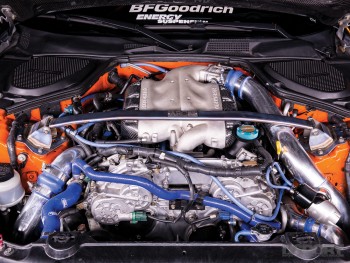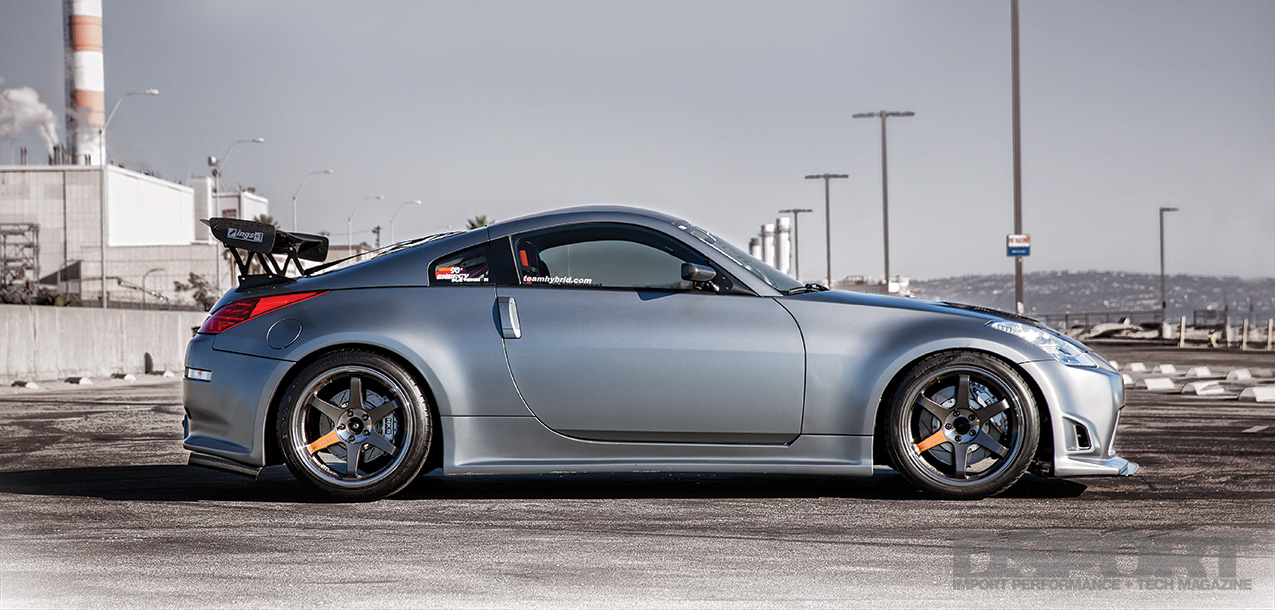FANATICAL OR FOOLHARDY?
 Indecision could prove one of the most costly mistakes one could make, and Spielman can attest to this first hand. He explained, “At one time, before I had even decided to build the engine, I had three turbo kits in my possession. One reason for doing this was because I was undecided about where in the RPM range that I wanted to make power. I was also on the fence about whether to build the engine or not. Either way, I was really excited to get started once I’d made up my mind, and having all of my options in my possession ensured that I would not lose any time waiting for a kit to arrive. One kit was very responsive and ideal for a stock engine. A second kit was designed for a built engine and peak power production. The third kit, produced by GTM Motorsports, offered what I perceived to be the best balance of response and peak power. It was intended to work well regardless of whether I employed a stock or a built engine. This is the turbo kit I decided to go with.”
Indecision could prove one of the most costly mistakes one could make, and Spielman can attest to this first hand. He explained, “At one time, before I had even decided to build the engine, I had three turbo kits in my possession. One reason for doing this was because I was undecided about where in the RPM range that I wanted to make power. I was also on the fence about whether to build the engine or not. Either way, I was really excited to get started once I’d made up my mind, and having all of my options in my possession ensured that I would not lose any time waiting for a kit to arrive. One kit was very responsive and ideal for a stock engine. A second kit was designed for a built engine and peak power production. The third kit, produced by GTM Motorsports, offered what I perceived to be the best balance of response and peak power. It was intended to work well regardless of whether I employed a stock or a built engine. This is the turbo kit I decided to go with.”
FROM BOOST TO BOOM
 The GTM Motorsports twin-turbo kit centers on a pair of Garrett GT2860RS turbochargers. These turbos rely on GTM cast manifolds to supply the high enthalpy exhaust gasses that drive the turbines and generate boost pressure. Once the compressed air has exchanged heat with the intercooler, hard piping feeds the intake charge through a stock throttle body before being distributed to the intake ports. Given the obvious increase in fuel demands required to support forced induction, a CJ Motorsports fuel return system, 600cc/min injectors and a 255-lph in tank fuel pump fortified the fuel delivery system. To regulate the larger injectors, Spielman chose to reflash the factory ECU using UpRev’s Osiris software. In the hands of Church Automotive, the Z was tuned to make 380 horsepower, as measured on a Dynapack Chassis Dyno. While this setup was adequate and enjoyable, the factory internals simply could not handle the cylinder pressure. In less than a year, the stock engine let go, and Spielman was forced back into the garage.
The GTM Motorsports twin-turbo kit centers on a pair of Garrett GT2860RS turbochargers. These turbos rely on GTM cast manifolds to supply the high enthalpy exhaust gasses that drive the turbines and generate boost pressure. Once the compressed air has exchanged heat with the intercooler, hard piping feeds the intake charge through a stock throttle body before being distributed to the intake ports. Given the obvious increase in fuel demands required to support forced induction, a CJ Motorsports fuel return system, 600cc/min injectors and a 255-lph in tank fuel pump fortified the fuel delivery system. To regulate the larger injectors, Spielman chose to reflash the factory ECU using UpRev’s Osiris software. In the hands of Church Automotive, the Z was tuned to make 380 horsepower, as measured on a Dynapack Chassis Dyno. While this setup was adequate and enjoyable, the factory internals simply could not handle the cylinder pressure. In less than a year, the stock engine let go, and Spielman was forced back into the garage.
BEAT DOWN, BUT NOT BROKEN
 While not part of his short-term plan, blowing his factory engine presented Spielman the perfect excuse to proceed forward with an engine built to his liking. He started with a set of Cosworth forged aluminum pistons in a 95.75mm offering. These pistons make the connection to the factory crankshaft by way of Carrillo H-beam connecting rods. ARP main studs secured the rotating assembly while ARP L19 head studs keep the cylinder heads secured to the block. To complement the strengthened hardware and in preparation for higher boost levels and the option to run E85, the fuel delivery system was further upgraded with Injector Dynamics ID1000 injectors. The injectors saturate the incoming air charge that is divided and distributed equally by way of a Cosworth intake manifold.
While not part of his short-term plan, blowing his factory engine presented Spielman the perfect excuse to proceed forward with an engine built to his liking. He started with a set of Cosworth forged aluminum pistons in a 95.75mm offering. These pistons make the connection to the factory crankshaft by way of Carrillo H-beam connecting rods. ARP main studs secured the rotating assembly while ARP L19 head studs keep the cylinder heads secured to the block. To complement the strengthened hardware and in preparation for higher boost levels and the option to run E85, the fuel delivery system was further upgraded with Injector Dynamics ID1000 injectors. The injectors saturate the incoming air charge that is divided and distributed equally by way of a Cosworth intake manifold.
[pullquote]THE Z SPUN THE ROLLERS OF OUR IN-HOUSE DYNOJET 424XLC2 DYNAMOMETER TO THE TUNE OF 480.75 WHP[/pullquote]Spielman’s Z33 now only needed a final tune to go with its new engine build. However, upon first firing, it started to bellow smoke from the exhaust. After the car sat at the engine builder’s shop for what felt like an eternity, Spielman towed the Z33 to the tuning shop Techno Square to be diagnosed. The rings seemed to be the issue, and once the engine was disassembled, the rings proved to be the wrong size for the atypical 95.75mm Cosworth pistons. This prompted a rebuild of the engine, which included reringing the pistons and blueprinting the block again. Once Techno Square had finished its work, the Z finally returned to Church Automotive to be tuned. With a tank full of 91-octane, the tables were optimized. The Z spun the rollers of our in-house Dynojet 424xLC2 dynamometer to the tune of 480.75 wheel horsepower and 435.25 lb-ft of torque.


